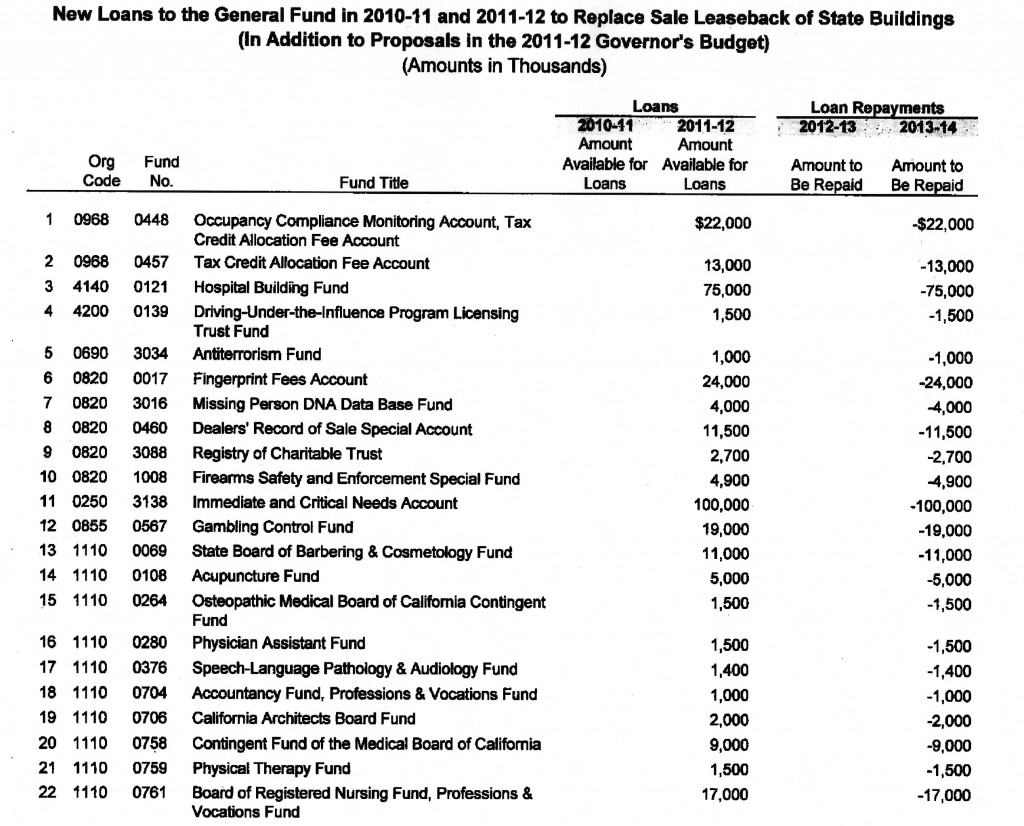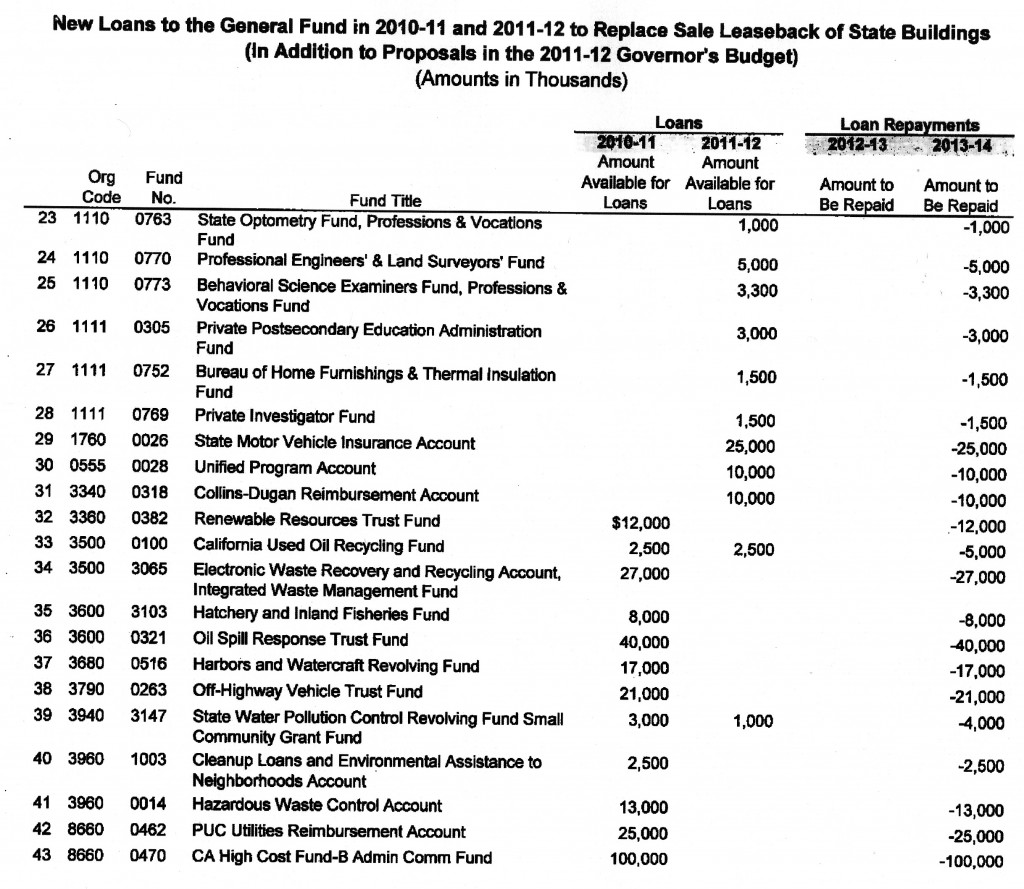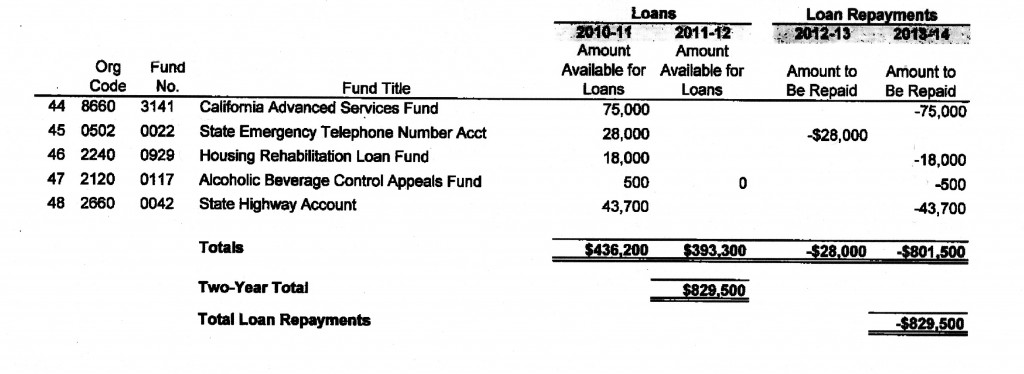How Gov. Jerry Brown’s Special Fund Loan Proposal Works
To replace the bulk of the $1.2 billion in one-time revenue lost by his cancellation of the Schwarzenegger administration’s proposed sale of 11 state office buildings, Gov. Jerry Brown proposes borrowing $830 million from 48 funds whose cash comes from fees and not general tax revenues.
Brown would transfer the reserve money in the 48 accounts to the cash-starved general fund while leaving enough cash on-hand for the normal operation of the entities the funds pay for – plus a one-month cushion.
“We want to ensure there still is a sufficient reserve for them to operate without a programmatic impact,” said H.D. Palmer, spokesman for Brown’s Department of Finance.
“If there’s a demonstration this action will have a material effect on programs or services paid for with these monies, the general fund will return the appropriate revenue.”

Nearly $424 million of the $830 million comes from six pots of money, including the seemingly aptly named, “Immediate and Critical Needs Account.”
Although not apparent from the title in the Democratic governor’s summary of his proposal, that account pays for the design, renovation, replacement, purchase or leasing of court facilities.
The purpose of two of the other six funds is similarly obscure. The California Advanced Services fund is slated to surrender $75 million to the state’s cash-poor general fund.
Established within the Public Utilities Commission, the fund is supposed to give $100 million in grants to telephone corporations to “promote universal service in unserved and underserved areas in the state.”
These grants, paid for by a .25 percent surcharge levied on phone customers, is to be used for projects that will “provide broadband services to areas currently without broadband access and build out facilities in underserved areas if funds are still available,” the PUC says.
Also at the PUC is the “California High Cost Fund-B Administrative Committee Communications Fund. It too is paid for with an “all-end-user surcharge.”
The fund pays for the costs of the committee that oversees this program and gives subsidies to AT&T, Verizon, Frontier Communications and Cox Communications in an attempt to keep the local telephone service to residential customers in high-cost areas more affordable.
The surcharge on consumers to pay for the program was reduced from 1.3 percent to .5 percent in January 2008, according to report by the PUC to the Legislature.
Purposes of the remaining three major sources from which the Democratic governor would borrow are more apparent.
The Hospital Building fund, from which $75 million would be borrowed, helps ensure new or renovated medical facilities meet seismic safety standards. The Oil Spill Response Trust Fund, a contributor of $40 million to the general fund, does just what the name implies.
That fund is maintained by a 25 cent-per-barrel fee paid by oil companies on petroleum products that arrive in California by port, pipeline or refinery.
The State Highway Account, where monies are deposited for use in maintaining or expanding California’s transportation system, would loan the general fund 43.7 million under Brown’s plan.


Among the other reserves the Democratic governor rakes off to the general fund are $47.1 million from his former place of employment, the Department of Justice.
The two largest contributors — $24 million and $11.5 million respectively, are the Fingerprint Fees Account, which has a current reserve of nearly $30 million and the Dealers’ record of Sale Special Account whose reserve is estimated to be $24.6 million in the fiscal year beginning July 1.
Also tapped are more than 15 of the regulatory boards and bureaus housed in the state Department of Consumer Affairs. The list runs from the Acupuncture Board to the Bureau of Home Furnishings and Thermal Insulation.
At $17 million the Board of Registered Nursing gives up the most. It is followed by $11 million from the Board of Barbering and Cosmetology which Brown estimates will take in $4.6 million from fines and penalties, $4.8 million from new licenses and nearly $9.5 million from license renewals by the state’s stylists and cosmetologists.
Brown proposes to pay back the money to all of the funds during the fiscal year that begins July 1, 2013.
-30-
Filed under: Budget and Economy
Capitol Cliches Conversational Currency Great Moments in Capitol History News Budget and Economy California History Demographics Fundraising Governor Legislature/Legislation Politics State Agencies
Opinionation Overheard Today's Latin Lesson
Restaurant Raconteur Spotlight Trip to Tokyo Venting Warren Buffett Welcome Words That Aren't Heard in Committee Enough

No comments yet.
RSS feed for comments on this post.